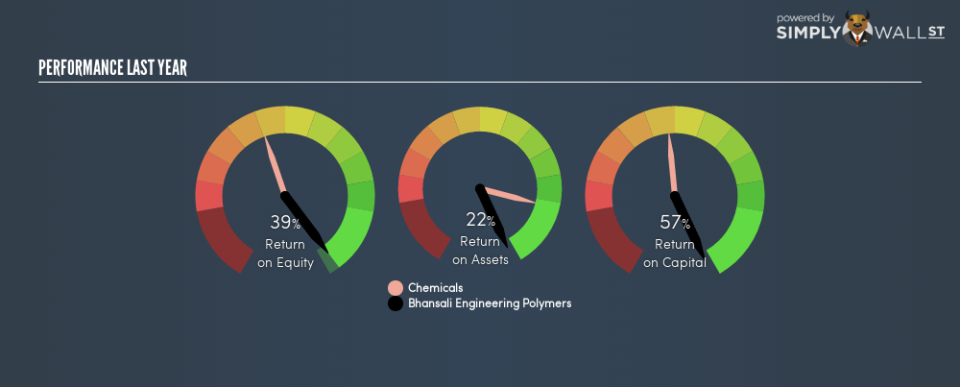Should You Like Bhansali Engineering Polymers Limited’s (NSE:BEPL) High Return On Capital Employed?

Today we are going to look at Bhansali Engineering Polymers Limited (NSE:BEPL) to see whether it might be an attractive investment prospect. Specifically, we’ll consider its Return On Capital Employed (ROCE), since that will give us an insight into how efficiently the business can generate profits from the capital it requires.
Firstly, we’ll go over how we calculate ROCE. Next, we’ll compare it to others in its industry. Last but not least, we’ll look at what impact its current liabilities have on its ROCE.
Understanding Return On Capital Employed (ROCE)
ROCE measures the amount of pre-tax profits a company can generate from the capital employed in its business. Generally speaking a higher ROCE is better. Ultimately, it is a useful but imperfect metric. Renowned investment researcher Michael Mauboussin has suggested that a high ROCE can indicate that ‘one dollar invested in the company generates value of more than one dollar’.
How Do You Calculate Return On Capital Employed?
Analysts use this formula to calculate return on capital employed:
Return on Capital Employed = Earnings Before Interest and Tax (EBIT) ÷ (Total Assets – Current Liabilities)
Or for Bhansali Engineering Polymers:
0.57 = ₹1.6b ÷ (₹4.2b – ₹1.5b) (Based on the trailing twelve months to March 2018.)
So, Bhansali Engineering Polymers has an ROCE of 57%.
See our latest analysis for Bhansali Engineering Polymers
Want to help shape the future of investing tools and platforms? Take the survey and be part of one of the most advanced studies of stock market investors to date.
Is Bhansali Engineering Polymers’s ROCE Good?
ROCE can be useful when making comparisons, such as between similar companies. Bhansali Engineering Polymers’s ROCE appears to be substantially greater than the 17% average in the Chemicals industry. We would consider this a positive, as it suggests it is using capital more effectively than other similar companies. Setting aside the comparison to its industry for a moment, Bhansali Engineering Polymers’s ROCE in absolute terms currently looks quite high.
As we can see, Bhansali Engineering Polymers currently has an ROCE of 57% compared to its ROCE 3 years ago, which was 11%. This makes us wonder if the company is improving.
When considering ROCE, bear in mind that it reflects the past and does not necessarily predict the future. Companies in cyclical industries can be difficult to understand using ROCE, as returns typically look high during boom times, and low during busts. This is because ROCE only looks at one year, instead of considering returns across a whole cycle. If Bhansali Engineering Polymers is cyclical, it could make sense to check out this free graph of past earnings, revenue and cash flow.
Bhansali Engineering Polymers’s Current Liabilities And Their Impact On Its ROCE
Short term (or current) liabilities, are things like supplier invoices, overdrafts, or tax bills that need to be paid within 12 months. The ROCE equation subtracts current liabilities from capital employed, so a company with a lot of current liabilities appears to have less capital employed, and a higher ROCE than otherwise. To check the impact of this, we calculate if a company has high current liabilities relative to its total assets.
Bhansali Engineering Polymers has total liabilities of ₹1.5b and total assets of ₹4.2b. As a result, its current liabilities are equal to approximately 36% of its total assets. Bhansali Engineering Polymers has a medium level of current liabilities, boosting its ROCE somewhat.
What We Can Learn From Bhansali Engineering Polymers’s ROCE
Still, it has a high ROCE, and may be an interesting prospect for further research. But note: Bhansali Engineering Polymers may not be the best stock to buy. So take a peek at this free list of interesting companies with strong recent earnings growth (and a P/E ratio below 20).
I will like Bhansali Engineering Polymers better if I see some big insider buys. While we wait, check out this free list of growing companies with considerable, recent, insider buying.
To help readers see past the short term volatility of the financial market, we aim to bring you a long-term focused research analysis purely driven by fundamental data. Note that our analysis does not factor in the latest price-sensitive company announcements.
The author is an independent contributor and at the time of publication had no position in the stocks mentioned. For errors that warrant correction please contact the editor at editorial-team@simplywallst.com.

